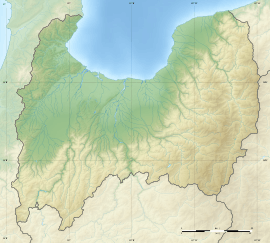Sugusaka Site
| 直坂遺跡 | |
 Sugusaka Site  Sugusaka Site (Japan) | |
| Location | Toyama, Toyama, Japan |
|---|---|
| Region | Hokuriku region |
| Coordinates | 36°33′35″N 137°13′12″E / 36.55972°N 137.22000°E |
| History | |
| Periods | Japanese Paleolithic |
| Site notes | |
| Excavation dates | 1971 |
| Ownership | National Historic Site |
| Public access | Yes |
Sugusaka Site (直坂遺跡) is an archaeological site in the city of Toyama in the Hokuriku region of Japan containing the ruins of a settlement from the Japanese Paleolithic period to the Jōmon period. It has been protected by the central government as a National Historic Site since 1981.[1]
Outline
The site is location on the right bank of the Jinzu River in what is now part of the Sarukurayama ski resort on the outskirts of the city of Toyama. In this vicinity there are a number of archaeological sites from the Japanese Palaeolithic to the Jōmon era, including the Nozawa site, Yagiyama Ono site, Naosaka Ⅱ site, Naosaka Ⅲ site, Naosaka IV site, indicating that this area has been densely populated since the earliest times. The Sugusaka site was discovered in 1971 during construction work for the establishment of a ranch, when a stone furnace dating from the middle of the Jōmon period was discovered. In response, in 1972 the Toyama Board of Education conducted excavation surveys of the area.
From the Japanese Paleolithic period, some 1200 stone blades were found. These blades were dated to about 25,000 to 30,000 years ago, and are thus the oldest thus found in the Hokuriku region. Apart from this, local polished stone axes and cusp heads of the age following this have been excavated. The site also contained thousands of fist-sized stones which had burn marks. These stones were used for cooking purposes.
Early examples of pottery were also found, including pottery with patterns created by a rolling die, and embossed pottery. These pottery shards were from the Hida, Shinano, Kinki and Tōkai regions indicating long range trade routes from a very early period in Japanese history.
See also
References
External links
- Toyama City official site (in Japanese)